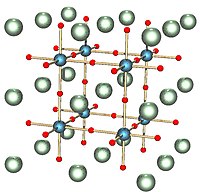
Photo from wikipedia
Abstract Oxide-ion conductors play a significant role in various applications such as solid oxide fuel cells (SOFCs), oxygen separation membranes and sensors. Recently, high ionic conductivity (~ 1 × 10− 4 S cm− 1 at 600 °C) was… Click to show full abstract
Abstract Oxide-ion conductors play a significant role in various applications such as solid oxide fuel cells (SOFCs), oxygen separation membranes and sensors. Recently, high ionic conductivity (~ 1 × 10− 4 S cm− 1 at 600 °C) was found in sodium bismuth titanate (NBT), which originates from oxygen vacancies compensating the introduced Bi-deficiency. By providing pathways with low diffusion barriers, the highly polarizable Bi3 + ions with 6s2 lone pair electrons and weak Bi O bonds are also beneficial for the migration of oxygen ions. Here we report the influence of lithium doping on the electrical properties of NBT. The optimal doping level of 4 at% Li on the Bi-site improves the ionic conductivity by one order of magnitude to ~ 7 × 10− 3 S cm− 1 at 600 °C without changing the conduction mechanism, which could be attributed to an increase in the oxygen vacancy concentration based on an acceptor doping mechanism. A further increase in Li content does not improve the total conductivity. Oxygen diffusion data were acquired by the Isotope Exchange Depth Profile (IEDP) method in combination with Secondary Ion-Mass Spectrometry (SIMS). The oxygen self-diffusion coefficients (e.g. 7.04 × 10− 9 cm2 s− 1 at 600 °C) are in excellent agreement with the values derived from impedance spectroscopy data, suggesting that the oxygen ions are the main charge carriers in the system. Furthermore, a degradation test was performed for 100 h under a variety of atmospheres, showing only a slight decrease in conductivity in both air and oxygen atmospheres attributed to the loss of material from the A-site. Comparison with other oxide-ion conductors indicates that Li-doped NBT materials are promising candidates for intermediate temperature SOFC applications.
Journal Title: Solid State Ionics
Year Published: 2018
Link to full text (if available)
Share on Social Media: Sign Up to like & get
recommendations!